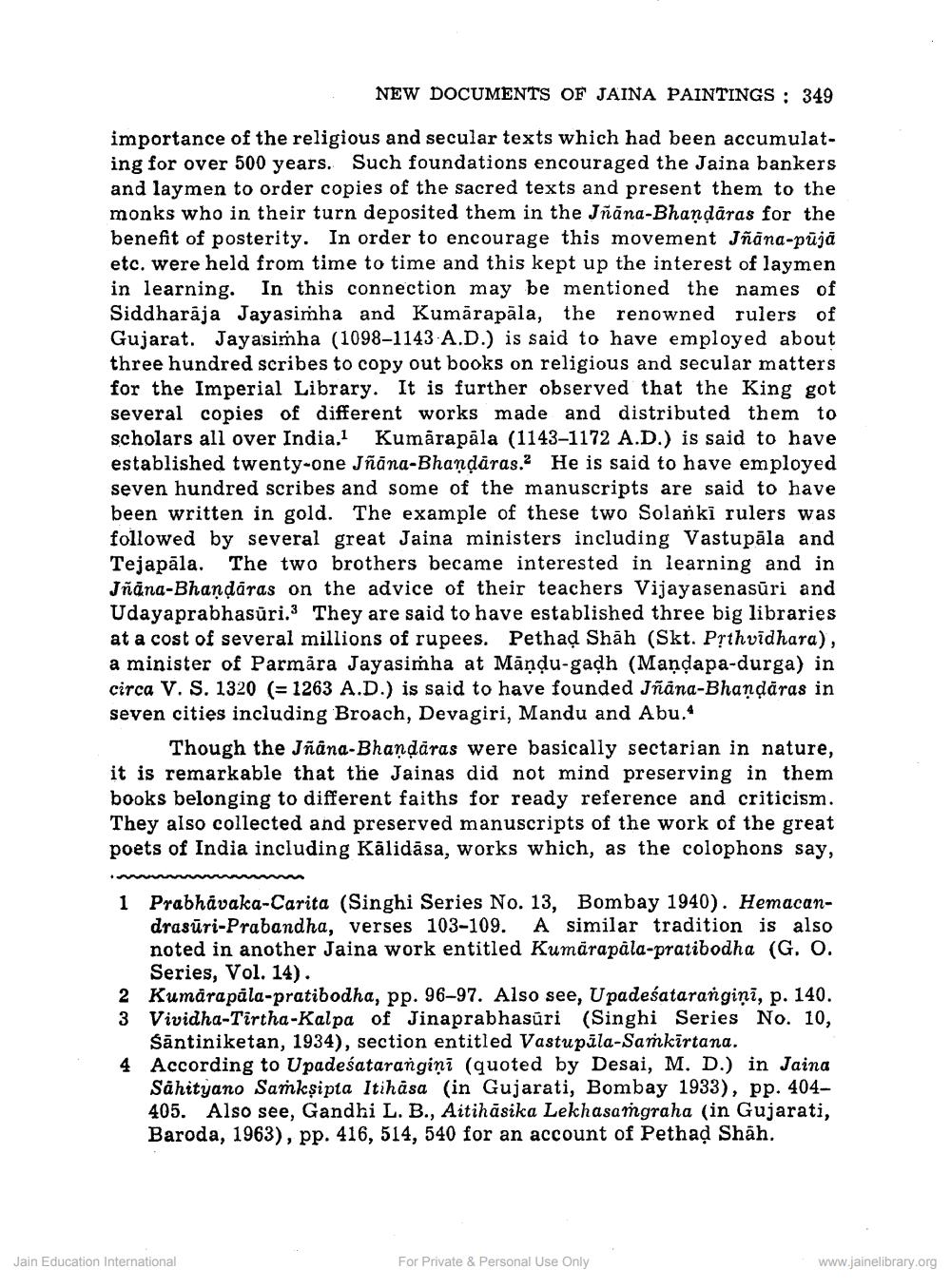Book Title: New Documents of Jaina Paintings Author(s): Moti Chandra, Umakant P Shah Publisher: Z_Mahavir_Jain_Vidyalay_Suvarna_Mahotsav_Granth_Part_1_012002.pdf and Mahavir_Jain_Vidyalay_Suvarna_ View full book textPage 2
________________ NEW DOCUMENTS OF JAINA PAINTINGS : 349 importance of the religious and secular texts which had been accumulating for over 500 years. Such foundations encouraged the Jaina bankers and laymen to order copies of the sacred texts and present them to the monks who in their turn deposited them in the Jñana-Bhaņdāras for the benefit of posterity. In order to encourage this movement Jñana-pūjā etc. were held from time to time and this kept up the interest of laymen in learning. In this connection may be mentioned the names of Siddharaja Jayasimha and Kumārapāla, the renowned rulers of Gujarat. Jayasimha (1098-1143.A.D.) is said to have employed about three hundred scribes to copy out books on religious and secular matters for the Imperial Library. It is further observed that the King got several copies of different works made and distributed them to scholars all over India. Kumārapāla (1143-1172 A.D.) is said to have established twenty-one Jñāna-Bhandaras. He is said to have employed seven hundred scribes and some of the manuscripts are said to have been written in gold. The example of these two Solanki rulers was followed by several great Jaina ministers including Vastupāla and Tejapāla. The two brothers became interested in learning and in Jñana-Bhandaras on the advice of their teachers Vijayasenasūri and Udayaprabhasūri.3 They are said to have established three big libraries at a cost of several millions of rupees. Pethad Shah (Skt. Pithvidhara), a minister of Parmåra Jayasimha at Māņdu-gadh (Mandapa-durga) in circa V. S. 1320 (= 1263 A.D.) is said to have founded Jñana-Bhandāras in seven cities including Broach, Devagiri, Mandu and Abu. Though the Jñana-Bhandaras were basically sectarian in nature, it is remarkable that the Jainas did not mind preserving in them books belonging to different faiths for ready reference and criticism. They also collected and preserved manuscripts of the work of the great poets of India including Kālidāsa, works which, as the colophons say, 1 Prabhavaka-Carita (Singhi Series No. 13, Bombay 1940). Hemacan drasūri-Prabandha, verses 103-109. A similar tradition is also noted in another Jaina work entitled Kumārapala-pratibodha (G. O. Series, Vol. 14). 2 Kumarapāla-pratibodha, pp. 96-97. Also see, Upadeśatarangiņi, p. 140. 3 Vividha-Tirtha-Kalpa of Jinaprabhasūri (Singhi Series No. 10, Sāntiniketan, 1934), section entitled Vastupāla-Samkārtana. 4 According to Upadeśatarangiņi (quoted by Desai, M. D.) in Jaina Sahityano Samkşipta Itihasa (in Gujarati, Bombay 1933), pp. 404405. Also see, Gandhi L. B., Aitihasika Lekhasamgraha (in Gujarati, Baroda, 1963), pp. 416, 514, 540 for an account of Pethad Shāh. Jain Education International For Private & Personal Use Only www.jainelibrary.orgPage Navigation
1 2 3 4 5 6 7 8 9 10
